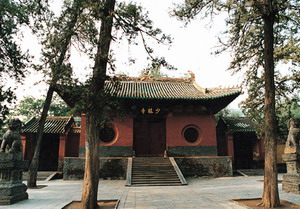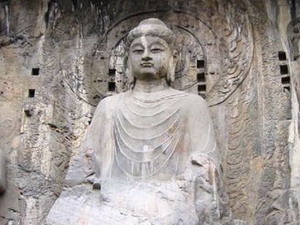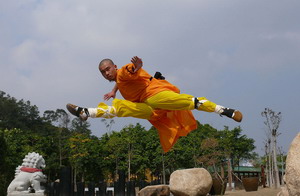The Shaolin Temple

The Shaolin Temple(literally Young Forest Temple) is a Buddhist temple at Mount Songshan in Henan Province. The Temple was built by the Emperor Hsiao-Wen in AD 496, and the first abbot of Shaolin was Batuo, (also, Fotuo or Bhadra (the Chinese transposition of Buddha), an Indian dhyana master who came to China in AD 464 to spread Buddhist teachings.
Long famous for its Shaolin Kungfu, the Shaolin Temple is the Mahayana Buddhist Temple perhaps best known to the Western world. The Shaolin Temple was built on the north side of Shaoshi, the western peak of Mount Song, one of the Sacred Mountains of China, by Emperor Xiaowen of the Northern Wei Dynasty. Bodhidharma is said by the Shaolin monks to have introduced the sect of Chan (Zen) Buddhism to them at Shaolin Temple in Henan, China during the 6th century.
Yang Xuanzhi, in the Record of the Buddhist Monasteries of Luoyang (AD 547), and Li Xian, in the Ming Yitongzhi (AD 1461), concur with Daoxuan's location and attribution. The Jiaqing Chongxiu Yitongzhi (AD 1843) specifies that this Temple, located in the province of Henan, was built in the 20th year of the Tàihé era of the Northern Wei Dynasty, that is, the Temple was built in AD 497.
The Shaolin Temple has been destroyed and rebuilt many times. Perhaps the best-known story of the Temple's destruction is that it was destroyed in 1644 by the Qing government for supposed anti-Qing activities (giving birth to the famous slogan "Destroy the Qing, restore the Ming!"); this destruction is also supposed to have helped spread Shaolin martial arts through China by means of the 5 fugitive monks Ng Mui, Jee Shin Shim Shee, Fung Doe Duk, Miu Hin and Bak Mei. This story commonly appears in martial arts history, fiction, and cinema.
In 1928, the warlord Shi Yousan set fire to the Temple, burning it for over 40 days, destroying 90% of the buildings including many manuscripts of the temple library.
The Cultural Revolution launched in 1966 targeted religious orders including the Temple. The five monks who were present at the Temple when the Red Guard attacked were shackled and made to wear placards declaring the crimes charged against them. The monks were jailed after being flogged publicly and parading through the street as people threw rubbish at them. The government purged Buddhist materials from within the Temple walls, leaving it barren for years.
Martial arts groups from all over the world have made donations for the upkeep of the temple and grounds, and are subsequently honored with carved stones near the entrance of the temple.
In the past, many people have tried to capitalize on the Shaolin Temple by building their own schools on Mount Songshan. However, the Chinese government eventually outlawed this, and so the schools all moved to the nearby towns.
A Dharma gathering was held between August 19 and 20, 1999, in the Shaolin Temple, Songshan, China, for Buddhist Master Shi Yong Xin to take office as abbot. He is the thirteenth successor after Buddhist abbot Xue Ting Fu Yu. In March 2006 Vladimir Putin of Russia became the first foreign leader to visit the Temple.





